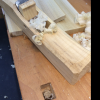Greetings:
I am technologically challenged to some degree, but I can post photos off my phone, so I will do the story telling on the sit down computer, and add photos via my phone.
I had more photos of the build, which spanned over a year, with the impetus to finish brought on by being asked to submit a piece to a juried show in a nearby town.
The piece started out as a spectacular piece of local Bigleaf Maple ( Western soft maple ) that my buddy had - I have never seen such grain on BLM: tiger stripe and pillowy quilt figure are the most common, then ' diablo ' maple that is crazy all over the place, then burl, but this piece is what I call an ' inverted quilt '. Live edge, about 5-3/4 feet long and about 20 '' wide and a full 2'' thick, we haggled over the price and it was mine. Flat sawn off a pretty large log, it had full live edge on both edges. I let it settle in the shop for over a year to see what it would do - amazingly, it stayed flat as could be - that was over 3 years ago now. He rough planed it in his 24'' Oliver, but there was some tearout, nearly 1/8'' deep due to the crazy grain.
The plan: Coffee table was the original idea, but I wanted something different in the way of legs, and am not a huge fan of live edge. Something in the way of supporting the top to the floor, without highlighting the live edge. Nothing came to mind, and endless surfing the 'net was fruitless. Sure, there are a bunch of ways to support a coffee table top, but I wanted something different, so, my twisted mind went to work.
'' Design something that draws your eyes to the figure of the wood '' I thought, but '' be minimalist in how that is accomplished '', all the while being unique and not bringing the live edge into the forefront. Also, how to deal with the straight edges where the slab was straight cut 90 degrees to the grain?
So, being someone who likes metal as well, I came up with the design for ' ZED ' ( ZEE to my American Creekers ) as in the last letter of the alphabet. Cut off part of the slab for the base, leave a 42'' x 20'' piece for the top. Make a substructure mortised into both the top and bottom slabs, connect those steel framework pieces with two one inch pieces of steel at a 45 degree angle.
So, you visually see the base ( which is the outside of the slab ) two pieces of solid steel rod come out of it at a 45 degree angle, and go into the bottom of the top slab, which is mounted 180 degrees to the bottom, so the outside of the slab on the top, is facing down - the figure was much better on this side BTW. Black out all the live edge, top and bottom, so your eye focuses on the figured wood, minimally connected by the two rods at 45 degrees.
Hopefully I haven't put anyone to sleep yet - more to come..





 Reply With Quote
Reply With Quote